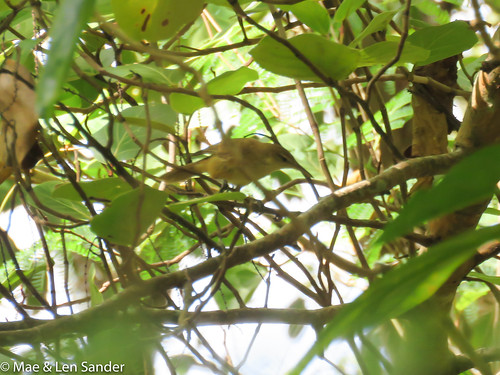 |
| What do you think of when you think of island food? Beautiful tropical fruit growing on trees? |
 |
On excursions from the National Geographic Orion last week, we learned
a little about agriculture and food in French Polynesia. |
 |
Coconut trees were brought to the islands on the voyaging canoes
of Polynesian settlers. They sprout from coconuts like the ones in the photo.
Coconuts provide delicious
coconut water, coconut milk, and tasty nut meat.
The leaves and bark fibers are useful as building material or textiles. |
 |
The ancient Polynesians brought chickens with them wherever they settled.
Today, chickens roam wherever they can find food for themselves.
They are an important source of meat. We saw these two cocks
having a fight not far from the vanilla plantation. |
 |
| Bora Bora has a lot of farmland on its well-watered hillsides, as do many of the larger and higher islands. |
 |
Living the life of the stone-age Polynesians -- the dream life -- would include working with your fellow villagers to trap
fish in a structure like this. At the top of the trap, a few people would chase fish in between the stone walls. At the
far end, where there's a little hut, a couple of people would spear the fish and collect them for a nice meal. |
 |
French Polynesia is currently a producer of vanilla, grown either outdoors
or in indoor farms like this. Like most of the tree fruit, vanilla orchids are
an introduced plant species, originally native to the New World. |
 |
The vanilla orchid produces the valuable pods, which are dried and
then processed to be sold worldwide. |
 |
Agricultural products from the open-air vanilla farm, showing both green
and dried (brown) vanilla pods and several types of nuts. |
 |
The price of vanilla beans and other vanilla products at the vanilla farms we
visited was just as high as vanilla prices everywhere, as we & our fellow passengers
all noticed. A current article in the Economist discusses vanilla prices,
though it provides only a sketchy reason for the variation. See "Vanilla Fever." |
 |
| Despite the dream of idyllic life on a tropical farm, most of the residents of French Polynesia purchase food in supermarkets. Wouldn't you love to have this view from the porch of your market? (That's our ship on the horizon.) |
The three food markets I saw during a walk down the main street on the atoll of Fakarava were rather small. The town has only around 800 people, with occasional provisioning visits from small sailboats and yachts, and it's almost flat, so there's little or no agriculture. In the markets, the selection of canned, frozen, and packaged goods was not that different from an American or a French supermarket. Although we drove past a number of markets on our tours of other islands, we didn't actually visit any of them.
We didn't see any fresh produce for sale. However, we heard that there had been a shipment of vegetables unloaded that morning, which had sold out immediately -- to the disappointment of some French tourists from a private boat who were ashore when we were. Unlike the larger islands where we saw small farms that raised fruit, vegetables, and animals like goats, cows, and chickens, Fakarava seemed to support only a few fishing boats to bring in food.
Historically, the islanders of French Polynesia relied on subsistence agriculture and fishing. In 1962, the French began to build a significant military presence, and also to develop tourism on the islands, which greatly altered the economy. The islands are now dependent on imported food, as we could guess even from our brief observations. According to Moody's Economic Analysis:
"French Polynesia’s tourism-dominated service sector accounted for 85% of total value added for the economy in 2012. Tourism employs 17% of the workforce. Pearl farming is the second biggest industry, accounting for 54% of exports in 2015; however, the output has decreased to 12.5 tons – the lowest level since 2008. A small manufacturing sector predominantly processes commodities from French Polynesia’s primary sector - 8% of total economy in 2012 - including agriculture and fishing." (source)
So it's interesting: these islands do not seem to be a food desert. But things are seldom as they seem; who knows?
 |
In Fakarava's markets we saw many familiar brands of food manufactured
in Japan, other Asian countries, Europe, and the US. |
 |
| The sign of another market. "Alimentation générale" means they sell all types of food. |
 |
| A bakery and market. The baked goods were also sold out when we looked inside. |
 |
This impressed me! They must be sending these cans and plastics a long
way to a recycling plant. It's around 500 km to Tahiti. |
Author of this content is Mae's food blog: Maefood dot blogspot.com.
If you are reading it somewhere else, it's been stolen!
All photos copyright 2019 by Mae & Len Sander.






















































